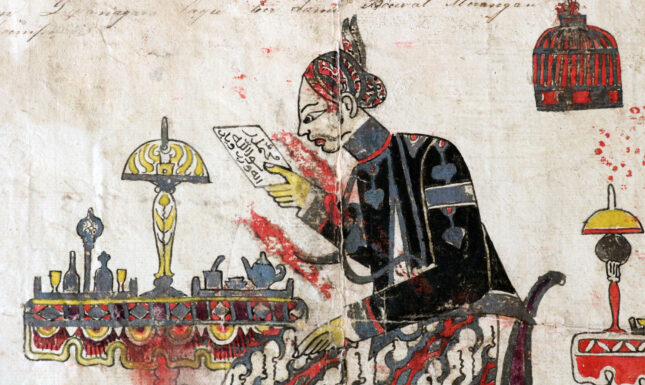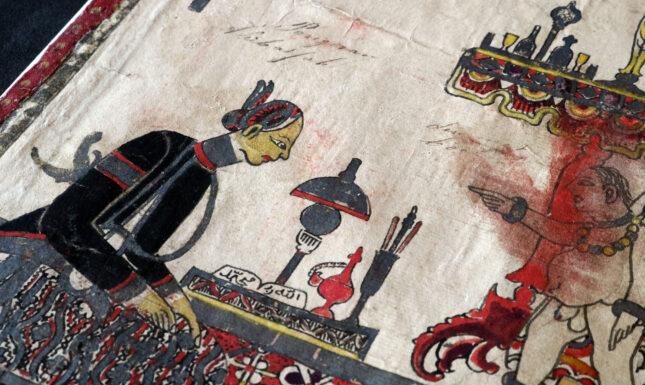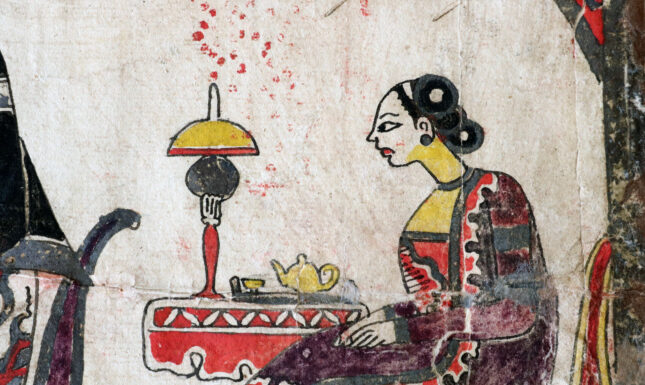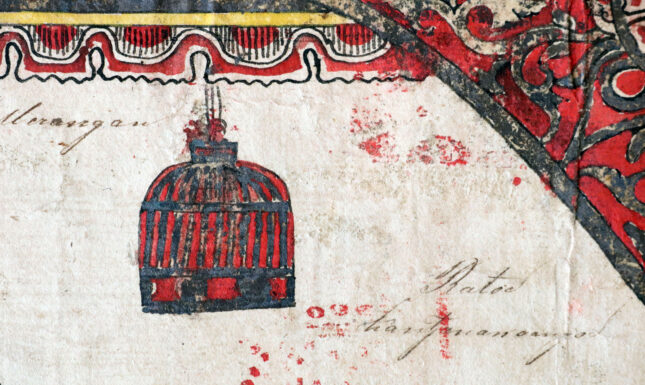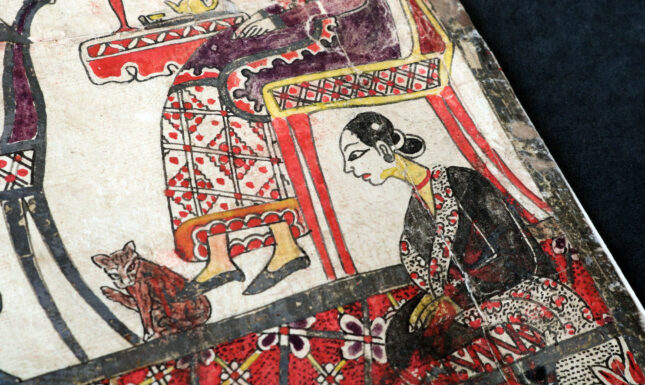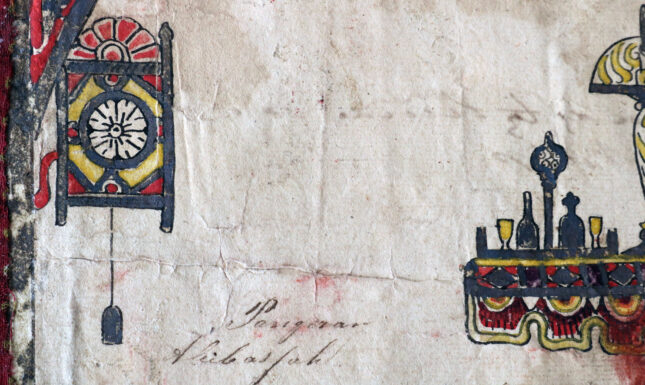Hidden Messages in a Painting of Prince Diponegoro
The bicentennial of the beginning of the Java War (1825-30) has once again placed Indonesia’s national hero Diponegoro (1785-1855) in the spotlight. A recent translation of his memoirs features a painting from Leiden University Library on its cover. This blogpost unravels its symbolic meaning.
The painting, showing Diponegoro on the eve of the Java War, was added to a folder containing handwritten papers from West Java including Islamic prayers and charms. The aquarelle was confiscated around 1892 from a Muslim cleric in Bandung who had fallen under the suspicion of the Dutch colonial authorities. Subsequently, it came into the possession of Christiaan Snouck Hurgronje (1857-1936), and after the latter’s death, it entered Leiden University Library under call number Or. 7398 B.
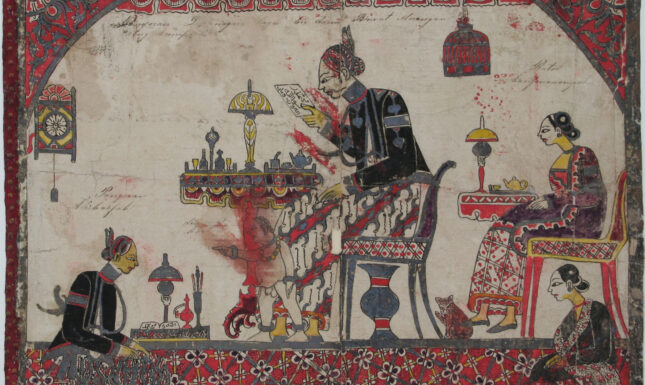

Diponegoro is the central figure in a room of mixed Javanese-Dutch design including such homely paraphernalia as teapots, oil lamps, and a pendulum clock on the wall. The bird cage hanging in the right-hand corner appears to be empty, which may symbolize the idea of freedom and being uncaged. The lamps on the tables could allude to Diponegoro’s name since he himself considered his name (Dipanagara in Javanese script) to mean “Lamp of the Land,” being a composition of dipa or “lamp” and nagara or “country.”
The decoration at the top of the painting is reminiscent of the floral pada mangajap sign which is commonly used in manuscripts made in Yogyakarta, functioning as a framing device to mark the beginning (or end) of a text. The heart-shaped form bears some similarity to the illuminations concerning Allah and the Prophet Muhammad in one of the mystical texts that are part of Or. 7398. The lower garment wrapped around Diponegoro’s waist is made of batik cloth with the Yogyakarta design of Parang Rusak (Broken Blade) which belongs to the “forbidden patterns,” traditionally only worn by members of the royal house of Yogyakarta and its retainers. Sitting behind him, at another table, is his wife Ratu Kancanawungu, having tea.
Prince Diponegoro is pictured as being totally absorbed in meditation, focusing on an Arabic text that is meant to represent an Islamic book, perhaps even the Quran. Apparently, the anonymous artist wanted to portray a resolute Diponegoro as a staunch defender of Islam just before the outbreak of the Java War, since the accompanying Malay caption states that he was preparing for war against the Dutch. In the lower left-hand corner, drawn on a considerably smaller scale and situated level with the female servant in the opposite corner, thus subtly conveying yet accentuating a sense of less importance, sits Prince Ali Basah (Pangeran Aliebassah). He has a text on a table before him, (incompletely) inscribed in Arabic with the Islamic confession of faith, namely “God is my Lord, Muhammad [is my Prophet].” His mind seems to be elsewhere.
Prince Ali Basah may be identified as none other than Diponegoro’s renowned army commander Prince Ali Basah Abdul Mustapa Prawiradirja alias Sentot (1808-1855). However, he did not share Diponegoro’s fate since he had already surrendered to the Dutch in 1829, subsequently changing sides, and serving the Dutch colonial army. A figure, which appears to be a naked male spirit pointing with his outstretched hand and index finger to Diponegoro’s once-closest ally, invites many questions. As the painting dates from long after the Java War, could this blunt gesture perhaps be interpreted as disrespectful, reviling Prince Ali Basah as a turncoat? Could this be a sign from the spirit world, hinting at what was to come, foretelling future defeat?
It should be remembered that this is not a realistic picture, but a carefully crafted mise-en-scène that aims to highlight Prince Diponegoro’s role as a pious Muslim and defender of Islam. Against this backdrop, the cat at the feet of his wife fits ideally as a marker of Islam. There are many stories about the Prophet Muhammad’s affection for cats, and there is even a remarkable saying, popularly ascribed to him but sometimes even to Allah (although the authenticity of both dicta is disputed), stating that “the love of cats is part of the faith.”
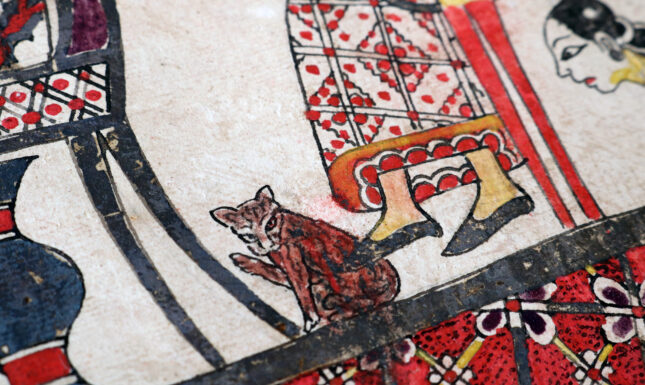

Diponegoro’s cat (shown above in close-up) is looking at us, and licking its back leg. Cats groom themselves by licking to maintain hygiene, and hence they can easily be associated with ritual purity which is a fundamental aspect of Muslim life. Western spectators may be reminded of the manicula (“little hand”) in European manuscripts, which in the margins of handwritten books functioned as pointers for drawing attention to important passages. However, pointing with a finger, let alone with a leg, is considered as most rude and a no-go in Javanese culture.
The female servant in the lower right-hand corner of the picture pays close attention to the cat. What could she possibly be thinking? Does she see something that escapes us? The most crucial question for a traditional Javanese audience would probably be whether a cat brings good or bad luck. Javanese cat lore, which is preserved in manuscripts but is also still available in printed notebooks on esoteric knowledge, may provide the answer. But while we know that eventually Diponegoro would lose the war, the Muslim cleric whose painting was confiscated more than sixty years after the outbreak of the Diponegoro War may have viewed its rich symbolism from a positive perspective, as a source of inspiration to keep fighting the good fight. Long after his death, and even today, Diponegoro remains a strong symbol of Indonesia’s fight for freedom.
About the authors:
Prof. Dr. Edwin P. Wieringa is Professor of Indonesian Philology with Special Reference to Islamic Cultures at the University of Cologne, Germany. Among his many publications on Indonesian literatures is his two-volume Catalogue of Malay and Minangkabau Manuscripts in the Library of Leiden University (1998, 2007).
Drs. Anita Emmerich teaches Dutch as a second language to non-native speakers.
The authors have known each other since studying Indonesian Languages and Cultures together at Leiden University in the 1980s. Apart from a love of cats, they share a common interest in all things Indonesian.



